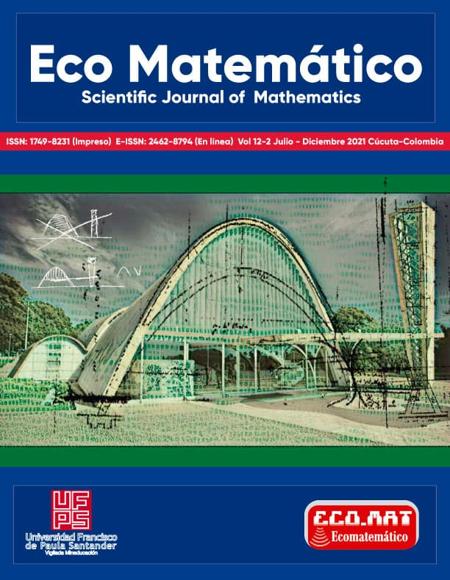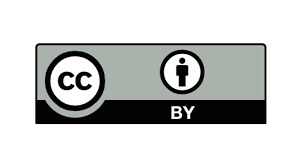Learning the composition of axial symmetries supported with GeoGebra® dynamic geometry software
Aprendizaje de la composición de simetrías axiales apoyados con el software de geometría dinámica GeoGebra®
Main Article Content
The objective of the research is to compare the learning in the composition of axial symmetries supported with GeoGebra in two groups of students, one through the teaching that is usually worked in the institution and the other with the Learning Based on Collaborative Projects (ABPC), in the midst of the pandemic due to COVID-19. The methodological approach of the research is mainly quantitative, it is supported by the U-Mann Whitney and Wilcoxon hypothesis tests. The activities were characterized by being synchronous (Microsoft® Teams Platform) and asynchronous (OneDrive®, GeoGebra and Teams). The Educational Institution has an emphasis on mathematics and is located in a municipality near the city of Bogotá – Colombia. The results show a statistically significant gain in both groups in learning the composition of axial symmetries; However, the group that worked with the ABPC presented a higher average in their learning. Among the main conclusions is that organizing the work, from the teaching activity, to be developed in a group through strategies such as the ABPC supported with GeoGebra, can potentially have a greater gain, in relation to the achievement of learning geometry.
Downloads
Article Details
Aiken, L. (1985). Three Coefficients For Analyzing The Reliability And Validity Of Ratings. Educational and Psychological Measurement, 45, 131–141. https://doi.org/10.1177/0013164485451012 DOI: https://doi.org/10.1177/0013164485451012
Arbain, N., y Shukor, N. A. (2015). The effects of GeoGebra® on students achievement. Procedia-Social and Behavioral Sciences, 172, 208-214 DOI: https://doi.org/10.1016/j.sbspro.2015.01.356
Badia, A. y García, C. (2006). Incorporación de las TIC en la enseñanza y el aprendizaje basados en la elaboración colaborativa de proyectos. Revista de Universidad y Sociedad del Conocimiento (RUSC). Vol. 3, n.° 2. UOC. Recuperado de: http://www.uoc.edu/rusc/3/2/dt/esp/badia_garcia.pdf
Bartolini-Bussi, M. G., y Mariotti, M. A. (2008). Semiotic mediation in the mathematics classroom: Artifacts and signs after a Vygotskian perspective (Trad. P. Perry). En L. English, M. G. Bartolini Bussi, G. Jones, R. Lesh y D. Tirosh (Eds.), Handbook of international research in mathematics education (pp. 746-783). Mahwah: Lawrence Erlbaum
Boluarte-Carbajal, A., y Tamari, K. (2017). Validez de contenido y confiabilidad inter-observadores de Escala Integral Calidad de Vida. Revista de Psicologia, 35(2), 641–666. https://doi.org/10.18800/psico.201702.009 DOI: https://doi.org/10.18800/psico.201702.009
Camargo, L., y Samper, C. (2013). Aproximación temprana al razonamiento geométrico en Educación Básica. In Simposio Nororiental de Matemáticas (Vol. 1, pp. 249-268)
Fajardo, M. D. C., y Larios, V. (2019). Descripción de procesos matemáticos en prácticas argumentativas. Educación Matemática, 31(3), 61-84
García, S., y López, O. (2008). La enseñanza de la Geometría. En Colección: Materiales para apoyar la práctica educativa Coordinación (Primera Ed). Instituto Nacional para la Evaluación de la Educación. https://www.inee.edu.mx/wp-content/uploads/2019/01/P1D401.pdf
Godino, J. y Ruíz, F. (2003). Geometría y su didáctica para maestros. Grupo Edumat, Universidad de Granada. España recuperado de https://www.ugr.es/~jgodino/edumat-maestros/
Gómez, C. L., y Ramirez, R. H. (2016). Comunidades de aprendizaje móvil, Mastery Learning y el problema 2 sigma como estrategias para el conocimiento previo en la resolución de actividades.
Guba, E. G., y Lincoln, Y. S. (1994). Competing paradigms in qualitative research. In N. K. Denzin y Y. S. Lincoln (Eds.), Handbook of qualitative research (pp. 105-117). Thousand Oaks, CA: Sage
Hernández-Sampieri, R., Fernández-Collado, C., y Baptista-Lucio, M. (2014). Metodología de la investigación (J. Mares-Chacon (ed.)). McGraw
Hill Intereamericana Editores S.A. http://www.casadellibro.com/libro-metodologia-de-la-investigacion-5-ed-incluye-cd-rom/9786071502919/1960006
Iglesias-Inojosa, M., y Ortiz-Buitrago, J. (2019). La Demostración en Geometría desde una Perspectiva Didáctica. Revista Iberoamericana de Educación Matemática, 55, 159–183. http://www.fisem.org/www/union/revistas/2019/55/aula01.pdf
Maldonado, M. (2008). Aprendizaje basado en proyectos colaborativos. Una experiencia en educación superior. Laurus, Vol. 14, Núm. 28, pp. 158-180. Recuperado de: http://redalyc.uaemex.mx/src/inicio/ArtPdfRed.jsp?iCve=76111716009
Mariotti, M. (2006). New artefacts and the mediation of mathematical meanings. Proceedings of the Seventeenth ICMI Study Conference “Technology Revisited”. http://ims.mii.lt/ims/konferenciju_medziaga/TechnologyRevisited/
Mariotti, M. A. (2009). Artifacts and signs after a Vygotskian perspective: the role of the teacher. ZDM, 41(4), 427-440 DOI: https://doi.org/10.1007/s11858-009-0199-z
Martin-Romera, A., y Molina-Ruiz, E. (2017). Valor del conocimiento pedagógico para la docencia en Educación Secundaria: diseño y validación de un cuestionario. Estudios Pedagógicos, 43(2), 195–220. https://scielo.conicyt.cl/pdf/estped/v43n2/art11.pdf DOI: https://doi.org/10.4067/S0718-07052017000200011
Moreno, L. (2014). Educación matemática: del signo al pixel. Bucaramanga: Universidad Industrial de Santander
McMillan, J. H., Schumacher, S., y Baides, J. S. (2005). Investigación educativa: una introducción conceptual. Madrid: Pearson
McMillan, J., y Schumacher, S. (2005). Investigación educativa. Editorial Pearson Educación S.A
Mesa, M. B., Morales, F. H. F., y DUARTE, J. E. (2018). Evaluación de una estrategia pedagógica basada en proyectos colaborativos mediados por TIC para el desarrollo de competencias en estadística
Ministerio de Educación Nacional (1998). Serie Lineamientos Curriculares. Recuperado de https://www.mineducacion.gov.co/1621/articles-89869_archivo_pdf9.pdf
Morera, L., Fortuny, J. M., y Planas, N. (2012). Momentos clave en el aprendizaje de isometrías en un entorno colaborativo y tecnológico. Enseñanza de las ciencias: revista de investigación y experiencias didácticas, 143-154
Quezada-Alfonso, C., y Robayo-Buitrago, J. (2021). El Aprendizaje de la Composición de Simetrías Axiales, Bajo la Estrategia ABPC y el Uso de la Geometría Dinámica (GeoGebra®) para Estudiantes de Grado Octavo del Colegio Refous. Universidad Distrital Francisco José de Caldas
Rubio-Pizzorno, S., y Montiel-Espinosa, G. (2017). Consideraciones que epistémicas sobre los objetos geométricos en ambientes de geometría dinámica. Análisis inicial. En L. Serna (Ed.), Acta latinoamericana de matemática educativa (pp. 1505–1514). Comité Latinoamericano de
Matemática Educativa
Sandoval-Cáceres, I. (2009). La geometría dinámica como una herramienta de mediación entre el conocimiento perceptivo y el geométrico. Educación matemática, 21(1), 5–27.
Suarez-Flórez, C., y Camargo-Uribe, L. (2019). Dynamic geometry and scientific reasoning: Duo to solve problems. Educacion Matematica, 31(1), 7–37. https://doi.org/10.24844/EM3101.01 DOI: https://doi.org/10.24844/EM3101.01
Suárez, O., Molina-Vásquez, R., Orjuela, P., y Lizarazo, J. (2020). Elementos para la construcción de un modelo de tutor virtual. Editorial Fundación Universidad Autónoma de Colombia.
Villamizar Araque, F. Y., Rincón Leal, O. L., y Vergel Ortega, M. (2018). Diseño de escenarios virtuales para problemas de optimización a través de geometría dinámica. Revista Logos Ciencia & Tecnología, 10(2), 67-75. https://doi.org/10.22335/rlct.v10i2.571 DOI: https://doi.org/10.22335/rlct.v10i2.571
Villamizar, F. Y. (2020). GeoGebra como herramienta mediadora de un fenómeno físico. Revista do Instituto GeoGebra Internacional de São Paulo. ISSN 2237-9657, 9(1), 76-89 DOI: https://doi.org/10.23925/2237-9657.2020.v9i1p76-89







